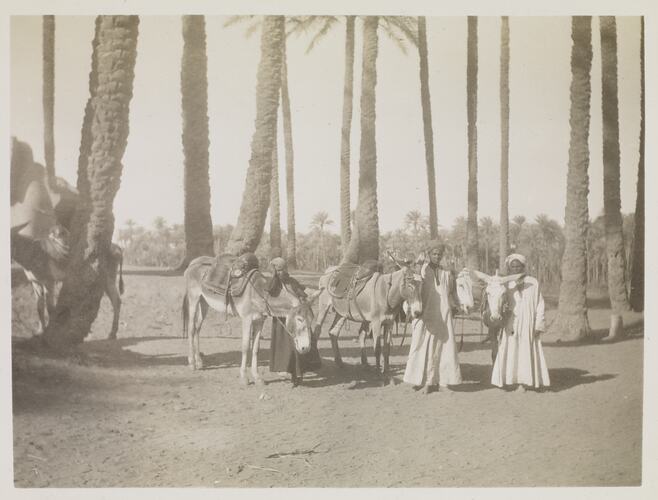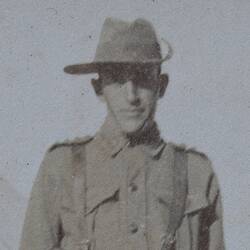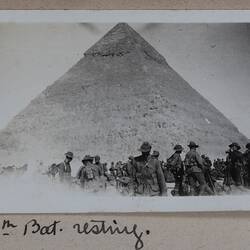Summary
One of 108 images in an album from World War I likely to have been taken by Captain Edward Albert McKenna. The album contains photographs of the 7th Battalion in Egypt.
The album relates to the service of Captain Edward Albert Mckenna. Edward Albert McKenna, born in Castlemaine, Victoria, was a 36-year-old department manager of soft goods when he enlisted on 17 August 1914. He lived at 5 St James Buildings, William Street, Melbourne, and had been married to Elizabeth Mary 'Lillie' McKenna since 1910. He embarked from Melbourne 19 October 1914 on the HMAT Hororata, second in command of a company in the 7th (Vic.) Battalion.
Captain McKenna was killed in action in Gallipoli around 25-30 April 1915, aged 37. His military records indicate an unusually large number of possessions for a soldier (although perhaps not so for an officer), including seven shirts, a pillow, six towels, a travelling rug, gumboots, pyjamas and slippers. Also amongst his possessions was a camera, and although no photographic prints or albums are mentioned in his military record, his trunk and 'parcels' may have contained them. These may have been left in storage in Egypt - Granville Ryrie, Commanding Officer of the 2nd Light Horse Brigade, records leaving his 'trunks here' [in Egypt] when he left for Gallipoli in mid-May (letter to his wife, 15 May, quoted in Gallipoli Sniper, John Hamilton, p.129).
Captain McKenna was buried at 7 Lone Pine Cemetery, Gallipoli. His details appear on the honours roll on the web page of the Australian War Memorial.
It is likely that his widow Lillie (Elizabeth) McKenna compiled the albums. The hand-writing on the back of the photographs differs from the inscriptions under each photograph, and it is possible that Edward inscribed them himself since they include eyewitness detail, and at least one (MM 107357) uses first person voice. If this is the case, he would have had them printed in Egypt - their light-weight paper, sometimes in poor condition, adds weight to this possibility. Lillie is likely to have assembled the album later, and written the more basic inscriptions on the album pages under the photographs.
Description of Content
The photograph shows three local Egyptian men dressed in thawbs and turbans holding amongst them the reigns of four saddled donkeys.They are standing in an open space with a number of tall palm trees located behind them. In the left of the photograph, another donkey is only just visible standing behind the trunk of a palm tree. In the far background, rows of tall palm trees are visible.
Physical Description
Black and white photographic print on paper with a white border.
More Information
-
Collection Names
Returned and Services League (RSL) Collection, Military Memorabilia Collection
-
Collecting Areas
-
Acquisition Information
Donation from Mr J. Willis, circa 1986
-
Acknowledgement
Mr. J. Willis
-
Place & Date Depicted
-
Photographer
Captain Edward A. McKenna - Australian Imperial Force (AIF), Egypt, 1914-1915
-
Creator
-
Format
Photograph, Black & White
-
Inscriptions
Hand written in ink on the support underneath the photograph: 'End of the Trip to Sakara' Hand written in pencil on the back of the photograph: 'Sakkara trip / End of trip / My donkey boy second from right / donk on his right hand side was / mine'.
-
Classification
-
Category
-
Discipline
-
Type of item
-
Image Dimensions - Photograph
108 mm (Width), 84 mm (Height)
-
Image Dimensions - Photograph album page
174 mm (Width), 141 mm (Height)
-
References
National Archives of Australia: McKenna Edward Albert, barcode 1949283, series B2455/1. 'Netjerikhet,' The Ancient Egypt Site, at: [Link 1] accessed: December 19, 2012
-
Keywords





